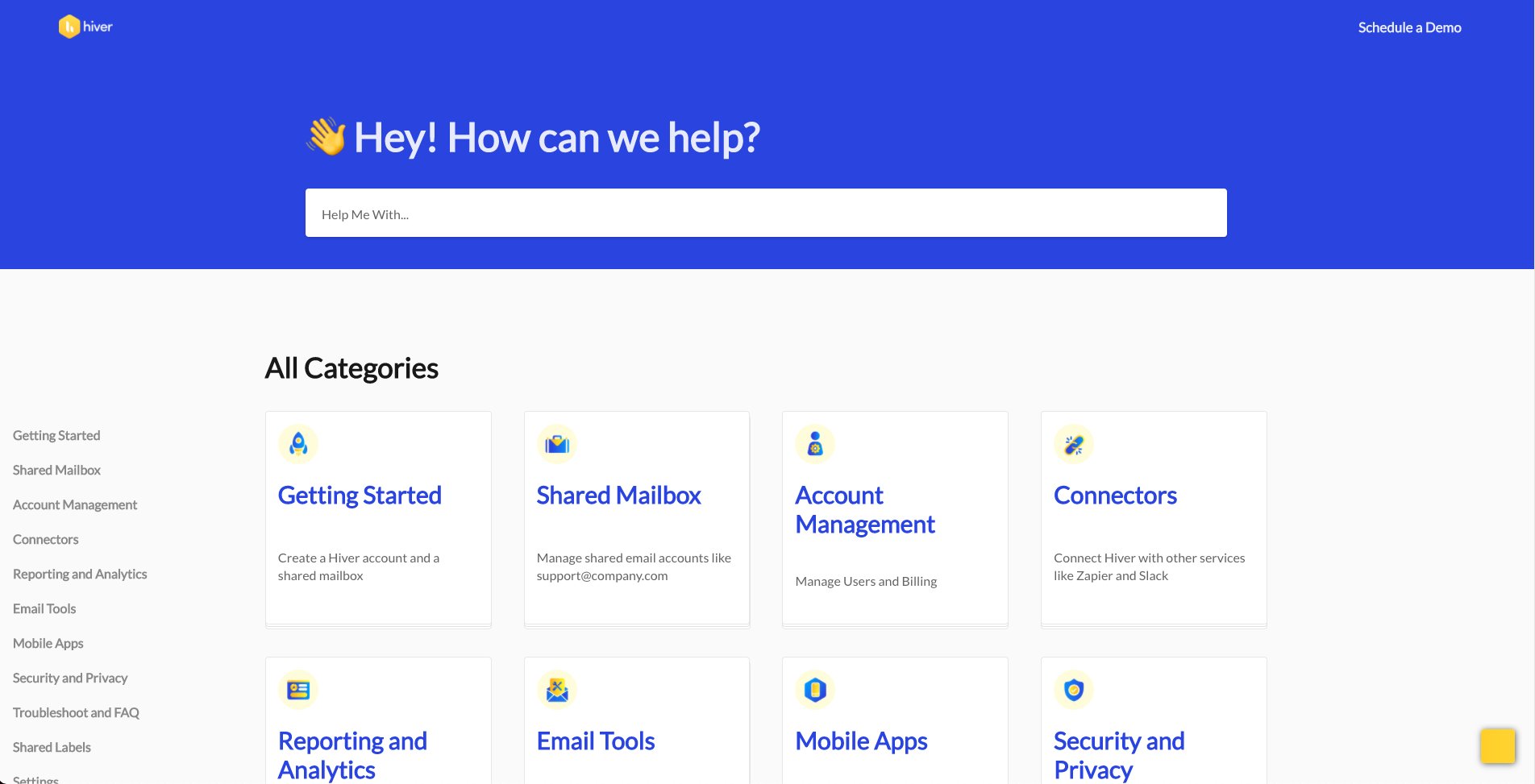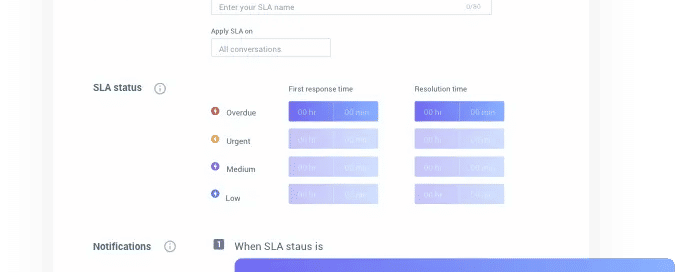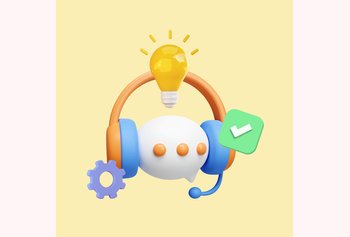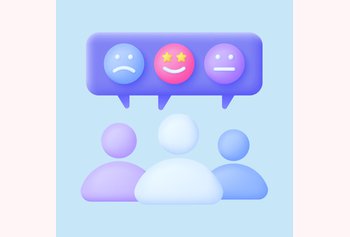6 B2B Customer Service Best Practices for Long-Term Success

Table of contents
Buying software is much different from something like buying a pair of sneakers.
When you’re buying a piece of software for your business, the process is far more elaborate. You’re likely hopping on multiple calls with the vendor, discussing pricing, features, and whether or not it meets your business needs. You’ll ask detailed questions, review your budget, and possibly even consult with your team.
On the other hand, buying sneakers is a much simpler affair. You walk into a store, choose a pair you like, pay, and leave. There’s no lengthy process or back-and-forth.
The key difference between the two scenarios is the complexity of the product in question. Generally speaking, B2B products and services are more technical and complex. The relationships between vendors and their clients are long-term and more dependent on trust.
These factors consequently make B2B customer service much more complex. A single misstep can jeopardize not only a deal but the entire business relationship.
In this article, I highlight 6 B2B customer service best practices you should implement if you want to build strong relationships with your clients and retain them in the long run.
But first, let’s look at how B2B customer service is different from B2C.
Table of Contents
- How is B2B customer service different from B2C?
- Complexities in B2B Customer Service
- 6 B2B customer service best practices you should implement
- B2B customer service is tough to crack, but pays off in the long run
How is B2B customer service different from B2C?
It is easier to understand the differences between B2B and B2C customer service if we know the basic distinction between the two types of businesses.
| Difference | B2B Customer Service | B2C Customer Service |
|---|---|---|
| Target audience | Businesses and teams | Individual consumers |
| Purchase value | High purchase value. High stakes. | Smaller, more frequent purchases |
| Sales process | Complex, time-consuming, often involves legal teams and contracts | Simpler, often a one-time transactional relationship |
| Customer expertise | Usually professionals, industry experts, or decision-makers | General consumers, with varying levels of product knowledge |
| Customer relationship | Built for the long term; trust and ongoing support are crucial | Transactional and shorter-term, often focused on immediate satisfaction |
B2C companies usually offer products and services built for individual consumers. B2B companies, on the other hand, sell to teams or businesses.
B2C buyers usually have smaller purchase sizes, and their buying decisions are generally governed by factors such as features, pricing, and discounts. B2C buyers, thus, tend to have a more transactional relationship with a brand.
B2B buyers often approach the process with a different set of priorities compared to B2C buyers. While pricing is important, it’s just one of many factors they consider. Reliability, scalability, and long-term value are equally, if not more, crucial. The sales process tends to be more complex and time-consuming, often involving legal teams, contracts, and multiple stakeholders.
Another difference between the two is that customer service staff in B2B companies almost always deal with professionals or subject matter experts on the other end. B2B clients are usually more tech-savvy, data-driven, and have their own set of customers to cater to.
In the words of Brian Halligan, HubSpot’s co-founder and CEO:
“If B2B companies want to get ahead of the game, they are going to have to get rid of all the friction in their business to better attract, engage, and delight customers… [In the past] your product needed to be 10 times better than the competition’s. Now, your customer experience must be 10 times lighter than the competition’s.”
Complexities in B2B Customer Service
B2B customer service is typically more complex than B2C customer service. Let’s take a look at why this is –
- The issues faced by B2B customers are more complex in nature – When you compare the nature of complaints and the processes required to solve them for B2B businesses as opposed to B2C ones, you’ll notice a stark contrast.
Think of the last time you, as an individual, reached out to a company for customer support. It was probably to return a damaged item or check on the status of your refund.
And apart from exceptional cases, the process is really simple. You would’ve reached out to the support team via live chat, social media, email, or phone. A customer service rep would have connected with you and resolved your query.
On the other hand, the B2B customer service process is a lot more complicated. This is mostly because B2B products/services are more technical in nature and so are the issues faced by users.
For instance, say you’re finding it difficult to create reports on your marketing automation platform. You’d have to reach out to the support team of the vendor who would then take time to figure out the root cause of the issue and offer a solution.
- Multiple teams get involved – Another reasonwhy B2B customer service is so complicated is because of the involvement of multiple teams. For B2C businesses, a single agent can handle the customer’s request. It’s a one-on-one relationship. Most likely, the buyer is the one who is facing the issue and has reached out for support.
Whereas in B2B, there are multiple stakeholders for a single purchase. This is true both for the customer and for the service provider.
For instance, an individual user may face an issue with the software that they are using at work. To raise a support request, the said user would have to inform their internal IT team, which would then escalate it to the head of IT, following which the head of IT will raise the issue with the service provider.
Again, on the service provider’s end, once an issue has been raised, depending on the nature of the issue, multiple customer service representatives and account managers might get involved depending on the complexity of the problem.
- There’s a deeper relationship between customer and vendor – In the B2C domain, interactions between support agents and customer are one-off. Usually, you don’t get to talk to the same person more than once and the relationship is completely transactional.
B2B customer service teams, however, deal with multiple stakeholders at different points in time and eventually, develop a personal connection with them. Some companies may even offer dedicated customer service reps to their high-value clients.
As a result of this, customers also begin to expect more. They expect their point-of-contact support agents to retain knowledge of past interactions and specific challenges. Different people even within the same team have different communication styles so adapting to that is another thing support teams need to be mindful of.
6 B2B customer service best practices you should implement
Here are 6 best practices that can transform the way companies in the B2B domain provide customer service –
1. Make your customer service proactive
Proactive customer service is about addressing potential issues before they arise, rather than waiting for your clients to reach out with complaints. This is especially important in B2B because businesses rely on consistent, uninterrupted service. When a problem occurs, it will most likely impact their operations, revenue, or even customer satisfaction.

Unlike in B2C, where proactive support is more about basic product updates or discounts, B2B customers expect more. They need regular insights about product performance, system updates, or any changes that could affect their business processes.
For instance, if you’re a software provider and foresee server maintenance that could cause downtime, informing your clients in advance can help them plan ahead and minimize disruption.
Aside from proactive communication, you’ll also do well to keep tabs on how well your customer is using your product. Think about if they’re making the most of all the features offered by your product or if they’re able to fulfill their organizational goals.
For example, if a client isn’t fully utilizing certain tools in your platform, offering personalized training sessions or resources can help them get more value from your product.
This kind of hands-on support gets noticed and is what will separate you from your competitors. Check out what Hiver’s customers are saying about the customer support they’re getting at Hiver –
“The customer service is literally the best…they respond almost instantly and will happily jump on a Google Meet call with you so you can walk through your issue.” – Source [G2]
“I’m also incredibly impressed with the responsiveness of their customer service – it’s never been a problem to get in touch with them! Whenever they direct me to other resources or offer advice on how to solve problems, their words always come through clearly, which is so reassuring when you’re looking for professional advice.” – Source [G2]
2. Have well-defined SLAs in place
SLAs or Service Level Agreements define the level of service a vendor provides, laying out the metrics by which the customer service is measured, and the penalties should agreed-on service levels not be achieved. Utilizing legal contract templates can help ensure these agreements are thorough and clear, safeguarding both parties in business transactions. It is a critical component of any vendor-client contract.
A study by Hiver found that close to 50% of customer service teams today have an SLA policy to resolve customer requests in under six hours.
And in the B2B domain, not all businesses are created equal. Some clients have more complex requirements than others. Some might have larger teams and thus might be of higher value to your company.
While it is not right to let one business cut in line and get ahead of another to receive customer service, it is perfectly acceptable to prioritize your support queue. This prioritization can be done with the help of SLAs.
SLAs can also help you prioritize your support queue based on your team’s bandwidth, the severity of the issues, and the type of customer.
3. Build multiple customer self-service options
You can save a lot of your agents’ as well as customers’ time by including self-service options in your strategy.
Think about it. A lot of your customer issues are really simple – resetting passwords, adding/deleting users, changing basic settings, billing issues, etc.
Most of your users are technical experts (given that they in turn work with other businesses) who should be able to handle these simple tasks on their own; all they need is a little nudge from your side. And this nudge can come in the form of various customer self-service options like knowledge base, FAQ sections, community forums, and chatbots.

A well-written self-service knowledge base consisting of how-to articles, product documentation, basic troubleshooting, how-to videos, and FAQs can help take a significant load off your support team. This would give them ample time to handle more complex support queries.
An organization that does this really well is Slack. Slack’s Help Center is a robust self-service resource, offering a range of articles, guides, and tutorials on common problems, product features, and troubleshooting.

Recommended read: 11 Best Knowledge Base Software for Your Business [2024]
4. Personalize your B2B customer service experience
B2B customer service is relationship-driven. You need to play the long game here, and to win at this game, you need to know your customers inside out. You need to build a solid rapport with all stakeholders and offer them personalized solutions.
Research by CMS Wire indicates that B2B customers expect the companies they work with to have all the context necessary to support them in their endeavors. This includes history of transactions, recent activity, and individual preferences.
In order to do this, you’ll have to arm the customer service team with the right customer service tools and data they need to truly understand their customers, both at a company and individual level. For example, you might invest in a conference call service that enables seamless collaboration among multiple stakeholders.
Every customer success rep must have access to a central database containing every customer’s touchpoints, support history, product details, and more. This gives your reps the context customers expect, allowing them to understand the customer’s needs without asking for repetitive or easily accessible information.
It’s a huge advantage if your help desk software is capable of integrating seamlessly with your other business software like your CRM tool or accounting software or marketing automation software. Because this way there’s a constant data sync between these systems. Everybody across teams will be on the same page with no scope for error. Your customers will get the personalized experiences they expect.
5. Collect and act on customer feedback
One of the most important items on this list is actually listening to what your customers are saying. Here’s the thing: in the B2C domain, the feedback you get from customers is usually about how that individual found your product to be. Whereas B2B customer feedback is more about how easy your product is to use, how easily it integrates with other tools/systems in the market, and whether or not it has helped the business achieve their goals.
Firstly, you’ll have to make it a point to regularly collect feedback through customer surveys, one-on-one interviews, and feedback forms. Even the complaints/queries you get will tell you where your customers are running into trouble or what the common problem areas are. Once you’ve identified these areas, you’ll have to take action and work on these areas so your customers have a better experience.
B2B clients want to see that their input is valued and that you’re taking tangible steps to improve your product or service based on their recommendations. Whether it’s adding new features, improving user experiences, or providing more training resources, closing the feedback loop shows your commitment to continually enhancing your offering.
With Hiver, you have the option to collect feedback from your customers with ease. You can either choose to insert the feedback survey into specific interactions or automate the process wherein you decide which emails will have the feedback survey embedded and which ones won’t.

Recommended read: A Detailed Guide to Customer Satisfaction Surveys
6. Provide Continuous Training and Support
And lastly, but equally important, make sure your customer service reps are given ongoing training. Unlike in B2C, the products being sold are technical and complex. On top of that, new features and updates are launched constantly so that the product is on par with market standards. You want your agents to constantly be on top of what’s going on with the product/service you’re offering.
When you provide regular training to your support team, it becomes easy for them to help out clients. It also becomes possible for them to guide clients to get the most of the product, and enable them to use features that actually impact business outcomes.
A capable, well-trained customer service team will stand out in the market and it’ll win you a reputation as a solid, reliable organization. To put things in perspective, here’s an awesome quote by customer service leader and speaker Shep Hyken –
For the customer, you are the company. Many customers will say, “I like doing business with them.” Who are they? Often it’s just one person, and that one person interacting with the customer has what I call ‘The Awesome Responsibility.’ At any given time, one person represents the entire company or brand, as well as all the people who work there. [Source]
Remember, your customer service team represents your brand and its values.
B2B customer service is tough to crack, but pays off in the long run
B2B customer service is tedious and unglamorous when compared to B2C customer service. B2B customers can also be a difficult lot to please. We’ve also come to see over and over again that B2B customer service is far more complicated than B2C customer service.
But, when done right, it can give your business an impenetrable competitive advantage. And of course, it’ll help you improve customer retention and your bottom line.
Now, isn’t that reason enough to invest in your customer service strategy if you’re running a B2B company?!



































